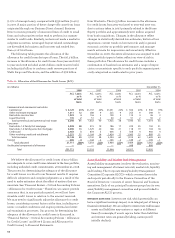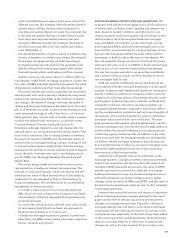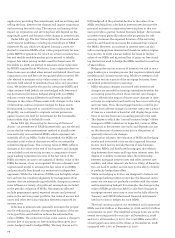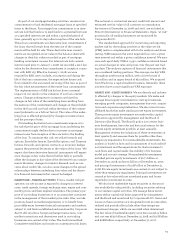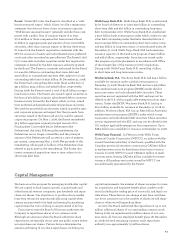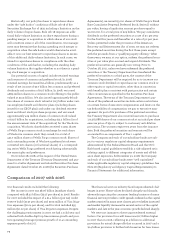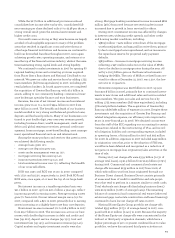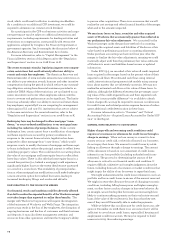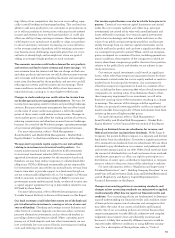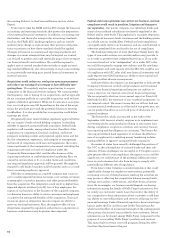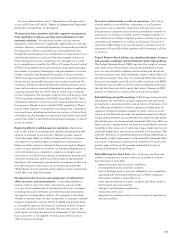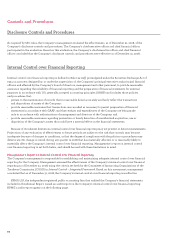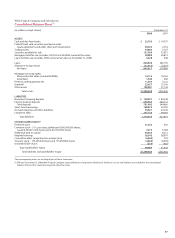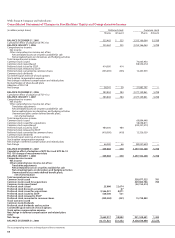Wells Fargo 2008 Annual Report Download - page 80
Download and view the complete annual report
Please find page 80 of the 2008 Wells Fargo annual report below. You can navigate through the pages in the report by either clicking on the pages listed below, or by using the keyword search tool below to find specific information within the annual report.stock, which could result in dilution to existing stockholders.
As a condition to an additional CPP investment, we could be
required to eliminate our common stock dividend.
As a participant in the CPP our business activities and corpo-
rate governance may be subject to additional restrictions and
requirements, including requirements for lending activities and
restrictions on compensation, some possibly with retroactive
application, adopted by Congress, the Treasury Department or
government agencies. See, for example, the discussion below of
the American Recovery and Reinvestment Act of 2009.
For more information, refer to “Capital Management” in the
Financial Review section of this Report and to the “Regulation
and Supervision” section in our 2008 Form 10-K.
The recent economic stimulus legislation imposes new compen-
sation restrictions that could adversely affect our ability to
recruit and retain key employees. The American Recovery and
Reinvestment Act of 2009 includes extensive new restrictions on
our ability to pay retention awards, bonuses and other incentive
compensation during the period in which we have any outstand-
ing obligation arising from financial assistance provided to us
under the TARP. Many of the restrictions are not limited to our
senior executives and cover other employees whose contribu-
tions to revenue and performance can be significant. The limita-
tions may adversely affect our ability to recruit and retain these
key employees, especially if we are competing for management
talent against U.S. and non-U.S. institutions that are not subject
to the same restrictions. For more information, refer to the
“Regulation and Supervision” section in our 2008 Form 10-K.
Bankruptcy laws may be changed to allow mortgage “cram-
downs,” or court-ordered modifications to our mortgage loans
including the reduction of principal balances. Under current
bankruptcy laws, courts cannot force a modification of mortgage
and home equity loans secured by primary residences. In
response to the current financial crisis, legislation has been
proposed to allow mortgage loan “cram-downs,” which would
empower courts to modify the terms of mortgage and home equi-
ty loans including to reduce the principal amount to reflect lower
underlying property values. This could result in our writing down
the value of our mortgage and home equity loans to reflect their
lower loan values. There is also risk that home equity loans in a
second lien position (i.e., behind a mortgage) could experience
significantly higher losses to the extent they become unsecured
as a result of a cram-down. The availability of principal reduc-
tions or other mortgage loan modifications could make bankruptcy
a more attractive option for troubled borrowers, leading to
increased bankruptcy filings and accelerated defaults.
RISKS RELATING TO THE WACHOVIA MERGER
Our financial results and condition could be adversely affected
if we fail to realize the expected benefits of the Wachovia merger
or it takes longer than expected to realize those benefits. The
merger with Wachovia Corporation will require the integration
of the businesses of Wachovia and Wells Fargo. The integration
process may result in the loss of key employees, the disruption of
ongoing businesses and the loss of customers and their business
and deposits. It may also divert management attention and
resources from other operations and limit the Company’s ability
to pursue other acquisitions. There is no assurance that we will
realize the cost savings and other financial benefits of the merger
when and in the amounts expected.
We may incur losses on loans, securities and other acquired
assets of Wachovia that are materially greater than reflected in
our preliminary fair value adjustments. We accounted for the
Wachovia merger under the purchase method of accounting,
recording the acquired assets and liabilities of Wachovia at fair
value based on preliminary purchase accounting adjustments.
Under purchase accounting, we have until one year after the
merger to finalize the fair value adjustments, meaning we could
materially adjust until then the preliminary fair value estimates
of Wachovia’s assets and liabilities based on new or updated
information.
Under SOP 03-3, we recorded at fair value all credit-impaired
loans acquired in the merger based on the present value of their
expected cash flows. We estimated cash flows using internal
credit, interest rate and prepayment risk models using assump-
tions about matters that are inherently uncertain. We may not
realize the estimated cash flows or fair value of these loans. In
addition, although the difference between the pre-merger carry-
ing value of the credit-impaired loans and their expected cash
flows—the “nonaccretable difference”—is available to absorb
future charge-offs, we may be required to increase our allowance
for credit losses and related provision expense because of subse-
quent additional credit deterioration in these loans.
For more information, refer to “Overview” and “Critical
Accounting Policies – Acquired Loans Accounted for Under SOP
03-3” in this Report.
GENERAL RISKS RELATING TO OUR BUSINESS
Higher charge-offs and worsening credit conditions could
require us to increase our allowance for credit losses through a
charge to earnings. When we loan money or commit to loan
money we incur credit risk, or the risk of losses if our borrowers
do not repay their loans. We reserve for credit losses by estab-
lishing an allowance through a charge to earnings. The amount
of this allowance is based on our assessment of credit losses
inherent in our loan portfolio (including unfunded credit com-
mitments). The process for determining the amount of the
allowance is critical to our financial results and condition. It
requires difficult, subjective and complex judgments about the
future, including forecasts of economic or market conditions that
might impair the ability of our borrowers to repay their loans.
We might underestimate the credit losses inherent in our loan
portfolio and have credit losses in excess of the amount reserved.
We might increase the allowance because of changing economic
conditions, including falling home prices and higher unemploy-
ment, or other factors such as changes in borrower behavior. As
an example, we are finding that borrowers are increasingly less
likely to continue making payments on their real estate-secured
loans if the value of the real estate is less than what they owe,
even if they are still financially able to make the payments.
While we believe that our allowance for credit losses was ade-
quate at December 31, 2008, there is no assurance that it will be
sufficient to cover future credit losses, especially if housing and
employment conditions worsen. We may be required to build
reserves in 2009, thus reducing earnings.


